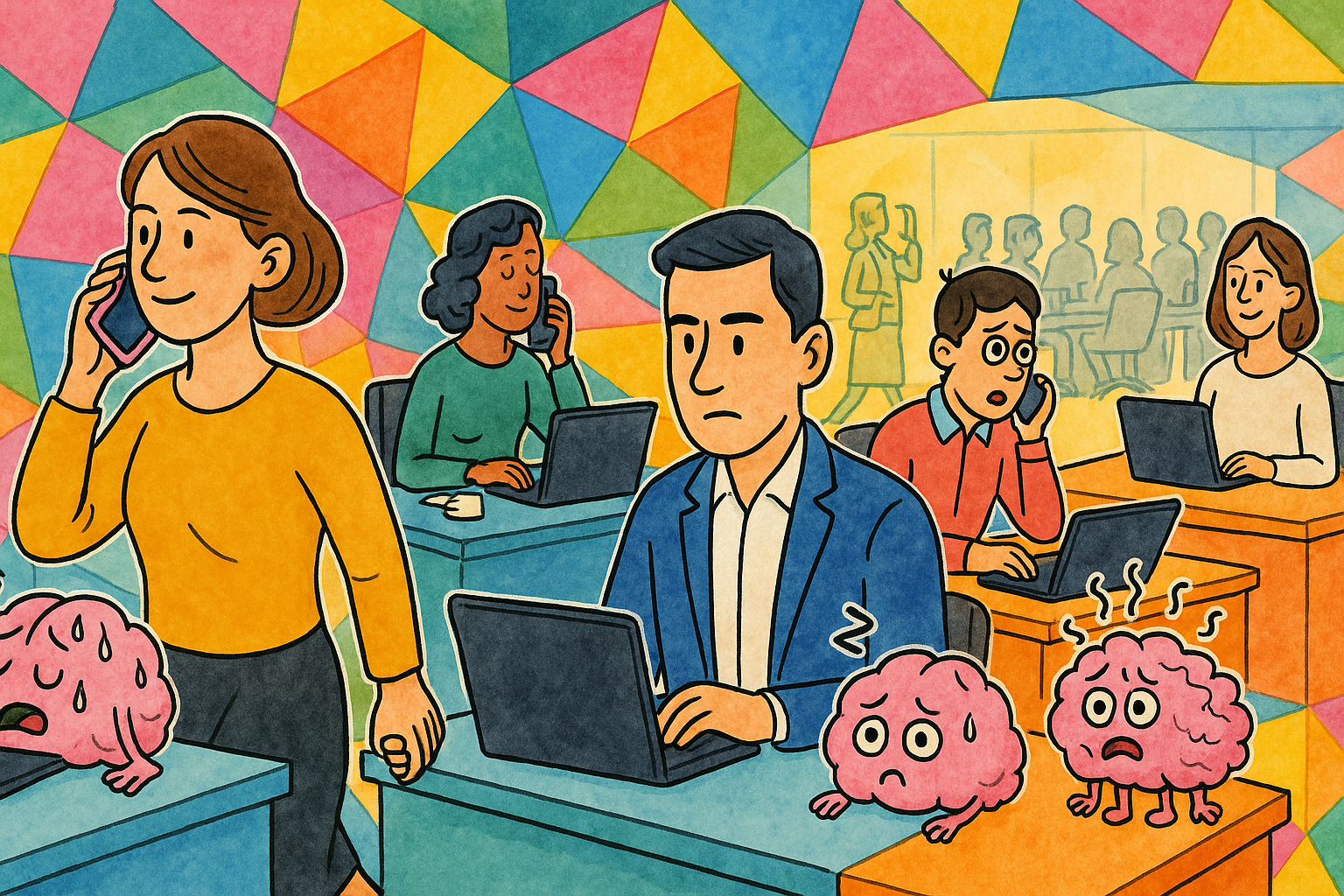We Got Resilience Completely Wrong, And It’s Costing Us Our Sanity and Health
Jun 1
·
Reading time: 11 minutes
- We’ve never had more tools for resilience, and we’ve never felt less resilient.
- That's because we’ve misunderstood what resilience really is. We’re solving for something… but it’s not resilience. True resilience isn’t toughness, it’s nervous system regulation.
- There are six key resilience myths.
- Even the best tools won’t work if they just add to your stress, exhaustion, or dysregulation.
- You can redesign for real resilience, personally and professionally.

1. We’ve never had more tools for resilience, and we’ve never felt less resilient.
Resilience is everywhere – in wellness apps, self-help books, motivational talks, HR workshops, and strategy meetings. But if resilience was the answer, wouldn’t we be seeing results by now?Instead, we seem to be in a full-blown well-being crisis:
- A Deloitte survey of US employees found that 77% report experiencing burnout at work.
- The 2024 Eurofound survey shows major declines in life satisfaction and optimism across the EU, particularly among those aged 35–64.
- According to Fairplay Talks 58% of employees on both sides of the Atlantic have considered quitting their jobs due to mental health challenges.
- Gallup’s State of the Global Workplace 2025 reveals 75% of workers aren’t engaged, 15% are actively disengaged, and 38% report daily stress.
- The Mental Health UK 2025 Report reports that 91% of UK adults experienced high or extreme stress in the past year, with 28% of young adults taking time off while waiting for NHS care.
Why?
Because we’ve misunderstood what resilience really is. We’re solving for something… but it’s not resilience.
2. If we wrongly understand what resilience is, how can we help people achieve it? (We can’t!)
Let’s take a closer look at how resilience is defined in the corporate world by the very companies we hire to teach it.- McKinsey defines resilience as the ability to deal with adversity and shocks and to continuously adapt for growth. In their words, it’s about thriving in hostile environments.
- Deloitte frames it as the ability to “bounce back quickly.”
- Korn Ferry focuses on how fast you return to calm after stress.
- Even the Resilience Institute, which claims to take a holistic view, says resilience is about rising above and turning challenges into opportunities.
All the definitions carry a dangerous message: If you’re burned out, tired, or unmotivated, it’s because you’re not tough enough. Maybe try pushing a little harder, talking to someone, taking a weekend off, and then come back on Monday to finish your job. As if the solution to drowning was to swim faster.
3. There are six resilience myths that are keeping us exhausted.
Myth #1: Resilience = Mental Toughness
We’ve been told to push through. Suck it up. Power on. We assume that if someone is tired, anxious, or burned out, they simply lack resilience. If you want to be resilient, override what your tired, exhausted body is telling you and listen to your mind. Keep pushing. Keep going.But here’s the twist: We don’t burn out because we’re weak. We burn out because we’ve been strong for too long.
Myth #2: Resilience = Mindset
Think positively. Journal. Set daily affirmations. While those tools can help, they also don’t address the root cause of burnout and emotional fragility. You can’t outthink a dysregulated nervous system. You can change your thoughts all day, but if your body is stuck in fight, flight, or freeze, you won’t feel safe, calm, or capable. Your biology will always override your mindset.Myth #3: “Just Do This One Thing”
Download an app. Practice mindfulness. Connect with a friend. So many experts advise us to focus on just one thing, and our lives will be good again. I hate to break it to you, but if you’re feeling burned out and mentally or emotionally exhausted, it’s doubtful that one app or solution will change how you feel. Resilience isn’t a quick fix. It’s a system-level reset.Myth #4: The Wrong Tool at the Wrong Time
If you know me, you know I’m a massive fan of yoga and meditation, and both have helped me immensely when I was in the depths of burnout. But it’s not just what you do, it’s when and how you do it. If you’re exhausted, overworked, and sleep deprived, getting up with the 5:30 AM Club to go to a yoga class, and then going to bed later to squeeze in that extra 30-minute evening meditation is likely going to do more harm than good. What helps when you’re regulated can hurt when you’re depleted. Context is everything.Myth #5: Coping Is Resilience
We’ve turned being busy and burned out into a badge of honor. But true resilience isn’t about how much stress, overwhelm, and pain you can tolerate before you collapse or your body gives out (that's coping and surviving).True resilience is about being able to recover from stress, and knowing when you’re passing a threshold that makes recovery impossible.
Myth #6: It’s Your Personal Failure
We’ve been conditioned to believe that if we’re not bouncing back, we’re doing something wrong. The entire framing of resilience is often built around self-blame. Just take another look at how the major players in the resilience training space talk about it: it’s never about the external environment; it’s always about the employee.But let’s be honest: It’s hard to feel resilient in a system that glorifies hustle, labels rest as laziness, and chronically dysregulates people. You can’t expect your employees (or yourself) to be resilient if the working environment is toxic. Companies need to take at least some accountability.
4. Resilience isn’t toughness. It’s nervous system regulation.
True resilience is your body’s ability to shift between stress and safety and come back to calm without getting stuck. That capacity lives in your nervous system, not your head, and the way to get there is definitely not pushing even more.When regulated, you feel grounded, present, and capable. When dysregulated, you enter survival mode — fight, flight, or freeze. You might be tired but wired, feeling overwhelmed and anxious, or constantly exhausted.
This isn’t just poetic. It’s biological. According to polyvagal theory, developed by neuroscientist Dr. Stephen Porges, your autonomic nervous system moves through three core states:
Safety
This is your baseline of true resilience. You can handle stress, recover quickly, and return to grounded awareness. Your system is flexible — able to shift into fight-or-flight mode when needed, then return to a calm state. This is where growth, creativity, and connection happen.
Fight or Flight
When your system detects a threat, it activates a defense mechanism. You get that jolt of energy and push through to overcome a challenge.
You’re still resilient here, but it depends on how long you stay. If your system responds to a challenge and can return to safety, this builds capacity. However, if the stress is chronic, relentless, or unsupported, your system begins to lose flexibility. You start to fray at the edges. Sleep gets disrupted. Emotions run high. You begin overriding your needs just to keep up. This is the early stage of resilience erosion.
You’re still resilient here, but it depends on how long you stay. If your system responds to a challenge and can return to safety, this builds capacity. However, if the stress is chronic, relentless, or unsupported, your system begins to lose flexibility. You start to fray at the edges. Sleep gets disrupted. Emotions run high. You begin overriding your needs just to keep up. This is the early stage of resilience erosion.
Freeze or Shutdown
This is where resilience breaks down. Your system stops trying to regulate because it no longer believes it can. You’re not bouncing back anymore, you’re just existing. In clinical terms, this often overlaps with symptoms of burnout, depression, chronic fatigue, or functional freeze.
Here, the nervous system is no longer adaptive. It’s protective. And ironically, this state — designed to help you survive — makes it most challenging to access the very things that rebuild resilience: connection, rest, and agency.
This isn’t to say we should avoid stress altogether. Stress isn’t the problem — staying stuck is. You can be in fight-or-flight and still be resilient, as long as you return to safety soon enough. But if you’re overburdened for too long, you cross a threshold. And after that point, you’re no longer building strength — you’re draining your system.
Freeze is a form of survival, not resilience. It’s your body pulling the emergency brake when it no longer sees a way out. And the longer you override its signals, the deeper you go. You’re surviving and coping (until you’re not). Each day beyond that threshold adds weeks or months to your recovery. That’s why people who hit burnout often need a couple of years to recover.
5. Why did we get it so wrong?
Because the mind is a master of override. We listen to the mind, not to anything from the neck down, and the mind is loud, linear, and doesn’t speak the body’s language.The mind, and our culture (which is just a collective of minds), push us to override our biology. The mind craves achievement, the ego feeds it, and hustle culture wraps it in moral praise. “Wow, she’s raising two small kids, runs her own business, volunteers, works out five times a week, has just started postgraduate studies, and still finds time to go on date nights, meet friends, and read books.”
But I hope it’s clear by now: this pattern of constant override isn’t resilience. It’s chronic dysregulation — the kind that slowly leads to disengagement, anxiety, overwhelm, and eventually burnout. Just look again at the statistics.
What we’ve come to accept as “normal” functioning is often just high-functioning survival. It’s not strength but rather self-abandonment. At best, it’s disconnection; at worst, it’s a form of self-harm — to your nervous system, your body energy, and health.
And the hardest truth? We often do it to ourselves. Yes, we can blame hustle culture or a toxic company environment. But many of us override voluntarily. We’ve internalized the script so deeply that we keep running it on our own.
6. Even the best tools won’t work if they just add to your stress, exhaustion, or dysregulation.
Many of us do “all the right things” to be resilient: we go to therapy, practice yoga, meditate, and take magnesium. And still, we don’t feel better. Why? There are two main reasons.1. You can’t regulate from the outside-in if your nervous system is stuck in survival mode.
Even the best tools won’t take hold if the system isn’t prepared to absorb them. It’s like trying to pour water into a bucket with a hole in it. You can keep adding more, but it drains right out.
The more you push to “fix” yourself with another 5:30 AM routine, the bigger that hole becomes. If your body is begging for rest and you respond by stacking more “healing” obligations onto your list, you’re reinforcing the problem.
- If you’re sleeping even less because you’re trying to fit in yoga and meditation into your morning and evening routines, it’s probably not a good idea.
- If you’re forcing yourself to go to a new mindfulness class, which spikes your social anxiety, that’s not going to help either.
- If you're tracking your sleep but feel worse every morning as the numbers look miserable, it just adds more anxiety instead of reducing it.
2. The nervous system has its own language, and it speaks somatically.
As someone who spent years in the land of intellect, this was hard to accept. But real nervous system regulation is non-verbal and body-based. Somatic practices — such as HRV (heart rate variability), certain breathing techniques, TRE (Tension and Trauma Releasing Exercises), Somatic Experiencing, or rhythm-based movement all these bypass your rational brain and send a direct signal of safety to your system. That’s the switch you’re looking for.7. You can redesign for real resilience, personally and professionally.
You can redesign your self-care practices, and you can reshape workplace practices to help people recover, regulate, and rebuild instead of pushing everyone further into exhaustion. This isn’t about eliminating goals or lowering standards. It’s about aligning with how the human nervous system works. That’s what makes change sustainable. And it’s doable – for individuals, teams, and entire companies.How?
We’ll get into that in the next two posts, where I’ll show you how to apply this approach whether you’re redesigning your own routines or rethinking how your company supports real resilience.





